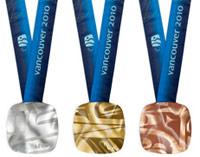
The first three-dimensional Paralympic medals were constructed with in a 30-step fabrication process. Photographs courtesy of the International Olympic Committee.
The word “athlete” is derived from a Greek term meaning “prize-seeker.” In the centuries since olive wreaths were awarded to ancient Greek winners in Olympia, the prizes for the largest sporting events on earth have clearly evolved. Canadian Veronica Brenner, 2002 Olympic silver medalist in aerials, recalled “The great part about the medals is it’s something that reminds you for the rest of your life of the journey. Every single medal and every athlete have their own story about what they had to put into it and how they got there. A medal should be shared. I know I wasn’t alone in winning this medal. When I was standing up on the podium, the last person I was thinking of was myself.”
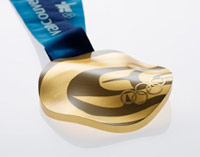
The medals’ undulating forms evoke the British Columbia’s wild landscape.
On October 15, the Vancouver Olympic Committee (VANOC), the Royal Canadian Mint, and Teck Resources Limited, Vancouver, Canada, unveiled the Olympic and Paralympic medals that will decorate the gold, silver and bronze medalists of the 2010 Winter Games. Their undulating forms evoke British Columbia’s mountains, ocean, and snow. Their faces are drawn from West Coast native artwork depicting the orca and raven. Each is unique, and their substantial size was designed to give each one a significant presence.
The Creators
According to VANOC, making the 2010 Winter Games medals was a two-year, collaborative effort among Canadian aboriginal designer/artist Corinne Hunt, internationally renowned industrial designer Omer Arbel, the Royal Canadian Mint, Teck Resources of Vancouver, and VANOC’s in-house design team. The IPC states that together, the team created medals that “reflect the magnitude of the accomplishments they represent: They are among the heaviest medals in Olympic and Paralympic history, weighing between 500-576g each. The Olympic medals are 100mm in diameter and about 6mm thick, while the Paralympic medals are 95mm wide and about 6mm thick.”
Orca and the Raven
VANOC stated that the surface designs for the medals are based on two large master artworks, one each for the Olympic and Paralympic games. “From each master artwork, each of the medals was hand-cropped,” VANOC said. “No crop is the same as another, making each medal unique.” The master artworks were created by Corrine Hunt, a Vancouver-based artist of Komoyue and Tlingit heritage. Hunt chose the orca as the motif for the Olympic medals, and the raven as the motif for the Paralympic medals.
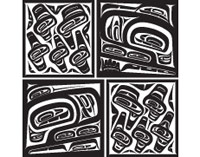
The master work for the Olympic medals is based on the form of a native bentwood box and the image of the killer whale.
The orca, designed across four panels in the style of a traditional West Coast native bentwood box, is associated with strength, dignity, and teamwork in many first nations myths. The black and white whales generally travel in pods through the waters off Canada’s west coast, but are also found in all the world’s oceans.
“The orca is a beautiful creature that is strong but also lives within a community,” said Hunt. “I felt the Olympic [Games] are a community, too. The athletes may be training, but they’re always somehow connected to their community, to their teammates, or to their country. The orca is a creature that has wonderful capabilities but can’t really survive without its pod.”
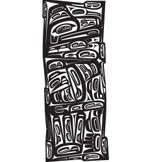
The master work for the Paralympic medals is based on the form of a totem pole and the image of the raven.>
VANOC stated that for Hunt, the raven is symbolic of Paralympians. In the Paralympic medals’ master work, its strong wings and profile appear in a three-part composition in the style of a totem pole. The raven is a species that can be found around the globe, is often associated with transformation and healing abilities, and represents determination, creativity, and wisdom.
“My design for the Paralympic medal-a raven on a totem rising-is close to my heart and in honor of my uncle, who is a paraplegic,” Hunt explained. “The raven is a creature that is all things, and I think Paralympic athletes have that in them. They’re sometimes given challenges and they rise above them, and the raven does the same. I think the creativity of the raven gives us hope-to accept when things don’t work out and really rejoice when they do.”
Sir Philip Craven, president of the International Paralympic Committee (IPC), supported Hunt’s use of the raven image: “The choice of the raven as the artwork is especially important to us because it symbolizes the powers of transformation and determination-qualities every Paralympian embodies on and off the field of play. No doubt the beauty of these medals will spur them even higher as they strive to reach their dreams and triumph against adversity yet again in 2010.”
Overall Medal Design
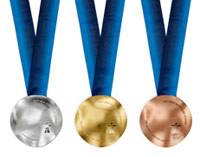
The Olympic medals are circular, and the Paralympic medals are a squared circle.
The Olympic medals are circular in shape, while the Paralympic medals are a squared circle. The matte orca or raven design is lasered onto the front face of the medals, and within this design is a delicate wood-grain pattern that can only be seen up close. Canadian industrial designer and architect Omer Arbel, also of Vancouver, used his knowledge of materials and fabrication processes to create an innovative three-dimensional undulating form for the medals, which are struck nine times each as part of an overall 30-step fabrication process.
Production Details
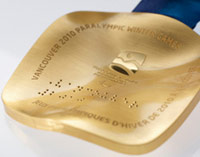
The backs of the Paralympic medals feature information in English, French, and braille.
The back of each medal contains the official names of the games in both English and French, the official languages of Canada, as well as Vancouver 2010’s distinctive emblems and the name of the sport and the event in which the medal was awarded. On the Paralympic medals, braille is also used. The entire medal is coated to prevent tarnishing, nicks, and scratches. The games’ motto, “With Glowing Hearts/Des plus brillants exploits” is written in white lettering on the medal’s blue and green ribbon where it will rest at the base of the neck.
The Royal Canadian Mint will produce 615 Olympic and 399 Paralympic medals for the 2010 Winter Games at its headquarters in Ottawa, Ontario. The mint began striking the medals in July and will finish them this November. It is the second time the mint has manufactured Olympic medals; the first time it produced them was for the Montreal 1976 Olympic Games. Teck Resources, a mining, mineral-processing, and metallurgical company, will supply the 2.05kg of gold, 1,950kg of silver, and 903kg of copper used in the medals’ production. The metals were sourced from Teck’s operations in British Columbia, Ontario, Newfoundland, Labrador, Alaska, Chile, and Peru.
To take a 360-degree interactive tour of the Vancouver 2010 medals, visit www.mint.ca
To view a video of the making of the Vancouver 2010 Medals, visit www.vancouver2010.com




